In October 2022, how will Madison and Fitchburg split the Town of Madison’s assets? What will happen to their employees? How does this work with redistricting? Are the town’s properties under assessed and what happens with the city’s higher tax rates? How will we give Town residents the same level of service when we won’t get levy increases sufficient to do the work? So many questions!
During the budget there were several remarks about what happens when parts of the Town of Madison are absorbed into the City in October 2022. There was a presentation to the Common Council Executive Committee about issues related to the dissolution, here’s what they were told and what the plans to make decisions are.
If you want to watch along start at the 2nd to last dot at 16:38
Jeff Greger from Planning is with Laura Larson from Finance to brief them on the Town of Madison final attachment process.
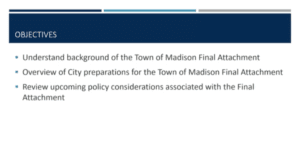 They will give background and an overview of what we’re doing as a city to prepare for that final attachment and then talk about some policy considerations that are associated with that attachment.
They will give background and an overview of what we’re doing as a city to prepare for that final attachment and then talk about some policy considerations that are associated with that attachment.
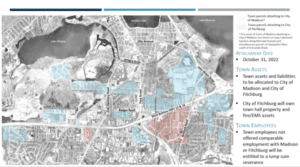 The map on the screen is showing you the bulk of the town of Madison that will be attached to either the City of Madison or the City of Fitchburg. There are a few parcels that are not shown on this map. There are some up along Sherman Avenue called Lakewood Gardens that will also become in the city and then there are few miscellaneous Parcels south of Schroeder road that will also be attached.
The map on the screen is showing you the bulk of the town of Madison that will be attached to either the City of Madison or the City of Fitchburg. There are a few parcels that are not shown on this map. There are some up along Sherman Avenue called Lakewood Gardens that will also become in the city and then there are few miscellaneous Parcels south of Schroeder road that will also be attached.
A couple of highlights of the agreement this all happens on October 31st 2022 at 11:59 p.m. The Town asses will need to be allocated between the City of Fitchburg and the City of Madison. The agreement as I recall, doesn’t really specify the percentages so that that will need to get worked out. Although the town hall will be within the City of Madison the City of Fitchburg will actually own the property as well as the fire and EMS assets. And then finally town employees that are not offered comparable employment with the City of Madison or City of Fitchburg will be entitled to a lump sum severance package.
A few numbers to consider as part of this attachment. The City of Madison will see approximately 5,000 new residents that equates to about just under twenty-four hundred additional housing units. 1400 unique parcel numbers coming into the city that equates to about just under 600 acres of land. We will be inheriting the center 12 miles of sanitary sewers, 3 lift stations. 4.5 miles of a storm sewer pipe, 1 stormwater detention Pond, just shy of 38 miles of streets, one bridge and two parks.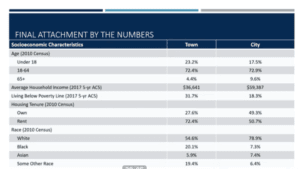
Some of the social economic characteristics of the town compared to the city. The town is fairly young as compared to the city of Madison about 23% of the population in the town of Madison is under the age of 18 compared to just under 18% in the city and the over-65 population is only 4.4% of population which compared to Madison is just under 10. The average household income significantly lower than the average $36,641 compared to the city’s $59,387. A fairly large population that are living below the poverty line just under 32% of the town population is living below the poverty line compared to 18% of the population for the city. Housing tenure is another big difference compared to the city. 72% rent in the town and 27% own compared to the cities almost fifty-fifty breakdown. Looking at race it’s a lot more diverse as compared to city populations so just under 55% of the population is white, 20% black/African American, just under 6% Asian. Unfortunately the census lumps a lot of other races into some other race they don’t split it out and that’s a fairly large percentage of the population 19.4%.
Alder Shiva Bidar asks about the census question about Hispanic/Latino and ethnicity, is that data not available or why is that data not there. Greger says they have the data, it is just not included in the slide. Bidar says the town has a very, very large latinx community so knowing what that percentage is is going to be very critical. Greger says they can include that in the future presentations.
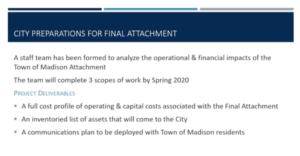 Laura Larsen from Finance says knowing that the attachment is coming and something that will have this is one of the largest scales attachments of the city is done in recent history, so it’s forcing us to prepare and rethink how we’re going to expand our service delivery on to those current Town residents who will become city residents in 2022. Knowing that this is coming and preparing we know that we can’t do it all in 2022 and we need to be ready to react to how will scale up service delivery already starting in 2021. So a project team has been working together so that over the next 6 months they can build out a full cost profile of what it will look like and how much it will cost to expand our service delivery into the town of Madison. Both from an operating perspective but also from a capital perspective so where do we need to be prepared to go in with targeted capital investment. We’re also working to inventory all of the assets so Jeff talked a little bit about how they’ll be split between the City of Madison and Fitchburg, but we also have to understand all of the physical infrastructure assets, their current status and how those come into the city’s overall inventory. That is getting into more detail around a lot of the Public Works assets. And most importantly we know that this is going to be a big change for folks who are currently Town residents who will be City residents so we’re also working together to build out of communications plan that can be deployed with Town residents so that we’re being very very intentional about communicating with them about what the attachment means for them.
Laura Larsen from Finance says knowing that the attachment is coming and something that will have this is one of the largest scales attachments of the city is done in recent history, so it’s forcing us to prepare and rethink how we’re going to expand our service delivery on to those current Town residents who will become city residents in 2022. Knowing that this is coming and preparing we know that we can’t do it all in 2022 and we need to be ready to react to how will scale up service delivery already starting in 2021. So a project team has been working together so that over the next 6 months they can build out a full cost profile of what it will look like and how much it will cost to expand our service delivery into the town of Madison. Both from an operating perspective but also from a capital perspective so where do we need to be prepared to go in with targeted capital investment. We’re also working to inventory all of the assets so Jeff talked a little bit about how they’ll be split between the City of Madison and Fitchburg, but we also have to understand all of the physical infrastructure assets, their current status and how those come into the city’s overall inventory. That is getting into more detail around a lot of the Public Works assets. And most importantly we know that this is going to be a big change for folks who are currently Town residents who will be City residents so we’re also working together to build out of communications plan that can be deployed with Town residents so that we’re being very very intentional about communicating with them about what the attachment means for them.
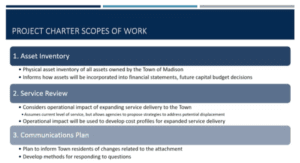 So that work is being carried out through three different scopes of work by a project team that has representation from all the different aspects of the city. So the first that I mentioned is the asset inventory so that’s where we’re working with current staff at the town of Madison to inventory out all of the physical infrastructure that they have. One thing that’s really important here is that all of those items have to come on to the city’s financial statements and so that again is something that we want to have a sense of what the impact will be before 2022 so that we can start to to prepare for that. That’s also going to be a really important tool in helping us to think about what are the 2021 capital budget and CIP need to look like as we look to those years of 22 through 26 next year. The next item is a service review, so when we think about expanding current services to the town of Madison we know that the attachment is going to impact city services in different ways so the streets division is going to have to look their routes in terms of how they redraw their routes to they can provide the same level of refuse collection, recycling collection, snow removal and that sort of thing. But we also know that services like the clerk’s office who will have to administer a Statewide election two weeks after the attachment also has to be thinking about everything that goes into administering the election and being prepared to do that. To make sure we don’t miss anything every single department is going to go through and prepare response for their different services to try to determine what’s the potential impact of the attachment and then what does that look like from an operations perspective that we have to ramp up for and then how do we start to put dollars behind that. So once we have the responses from all the Departments we will compile that into a comprehensive list profile so we know what that means. Finally like I mentioned communications around this is going to be vitally important. So staff from planning in cooperation with the PIOs is working together to develop a plan for the messaging and then how that will be carried out in terms of how we work with Town of Madison residents. This staff group has been meeting over the summer we’ve organized ourselves around the project, established timelines essentially what’s going to happen over the fourth quarter is agencies are going to work through the process of completing their service inventories, we’ll complete our work with the Town of Madison staff to begin the asset inventory, the PIOs will be developing some of the fundamental pieces of the communications plan. After we come back after the first of the year, from the asset side of from the service inventory side, my team and I will be putting dollars behind what agencies have provided to us so that we can put out a comprehensive report that we can take to the mayor’s office and bring back to council so some of the policy considerations can start to be discussed.
So that work is being carried out through three different scopes of work by a project team that has representation from all the different aspects of the city. So the first that I mentioned is the asset inventory so that’s where we’re working with current staff at the town of Madison to inventory out all of the physical infrastructure that they have. One thing that’s really important here is that all of those items have to come on to the city’s financial statements and so that again is something that we want to have a sense of what the impact will be before 2022 so that we can start to to prepare for that. That’s also going to be a really important tool in helping us to think about what are the 2021 capital budget and CIP need to look like as we look to those years of 22 through 26 next year. The next item is a service review, so when we think about expanding current services to the town of Madison we know that the attachment is going to impact city services in different ways so the streets division is going to have to look their routes in terms of how they redraw their routes to they can provide the same level of refuse collection, recycling collection, snow removal and that sort of thing. But we also know that services like the clerk’s office who will have to administer a Statewide election two weeks after the attachment also has to be thinking about everything that goes into administering the election and being prepared to do that. To make sure we don’t miss anything every single department is going to go through and prepare response for their different services to try to determine what’s the potential impact of the attachment and then what does that look like from an operations perspective that we have to ramp up for and then how do we start to put dollars behind that. So once we have the responses from all the Departments we will compile that into a comprehensive list profile so we know what that means. Finally like I mentioned communications around this is going to be vitally important. So staff from planning in cooperation with the PIOs is working together to develop a plan for the messaging and then how that will be carried out in terms of how we work with Town of Madison residents. This staff group has been meeting over the summer we’ve organized ourselves around the project, established timelines essentially what’s going to happen over the fourth quarter is agencies are going to work through the process of completing their service inventories, we’ll complete our work with the Town of Madison staff to begin the asset inventory, the PIOs will be developing some of the fundamental pieces of the communications plan. After we come back after the first of the year, from the asset side of from the service inventory side, my team and I will be putting dollars behind what agencies have provided to us so that we can put out a comprehensive report that we can take to the mayor’s office and bring back to council so some of the policy considerations can start to be discussed.
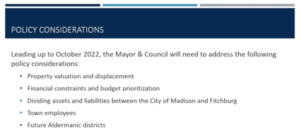 Some of the things that the team just anticipates will be serious policy considerations that will be taken up in the lead up to October 2022 is how do we prepare for the changes in property valuation that will come with the attachment and then mitigate displacement and be very very proactively prepared for how we have very real solutions ready for current residents. Again the timing is so we can start to do things in 2021 ramping up rather than having to ramp everything up all at once, but we do know just by financial constraints that the list of what we’ll come back from agencies in terms of how we scale services is going to exceed the additional Levy capacity that we will realize from the Town of Madison attachment. Just like we have to do every year in the budget, we’re going to have to do some prioritization about how we can accommodate meeting these needs and scaling up our services. There’s additional discussions that have to be has between the City of Madison and City of Fitchburg residents about dividing the assets and liabilities and what that will actually look like and how we will operationalize that. There’s also the issue around town employees and how we find the best opportunities for them whether whether that’s with us here at the City of Madison or joining the City of Fitchburg but finding the best fit for their skill sets so that they can continue to be assets to our community. Finally there will be considerations to how aldermanic districts are drawn so this will be happening in 2022 and so that we’ll just have to be part of the discussion when we talked about redistricting that will follow the 2020 census and then how we want to anticipate this in that process. That is by no means an exhaustive list, but those are items that have come up in our staff meetings as they have talked about the topic. They wanted to end there to preview some things that you’ll have to start thinking about after you see the final work of our product late in the first quarter of 2020.
Some of the things that the team just anticipates will be serious policy considerations that will be taken up in the lead up to October 2022 is how do we prepare for the changes in property valuation that will come with the attachment and then mitigate displacement and be very very proactively prepared for how we have very real solutions ready for current residents. Again the timing is so we can start to do things in 2021 ramping up rather than having to ramp everything up all at once, but we do know just by financial constraints that the list of what we’ll come back from agencies in terms of how we scale services is going to exceed the additional Levy capacity that we will realize from the Town of Madison attachment. Just like we have to do every year in the budget, we’re going to have to do some prioritization about how we can accommodate meeting these needs and scaling up our services. There’s additional discussions that have to be has between the City of Madison and City of Fitchburg residents about dividing the assets and liabilities and what that will actually look like and how we will operationalize that. There’s also the issue around town employees and how we find the best opportunities for them whether whether that’s with us here at the City of Madison or joining the City of Fitchburg but finding the best fit for their skill sets so that they can continue to be assets to our community. Finally there will be considerations to how aldermanic districts are drawn so this will be happening in 2022 and so that we’ll just have to be part of the discussion when we talked about redistricting that will follow the 2020 census and then how we want to anticipate this in that process. That is by no means an exhaustive list, but those are items that have come up in our staff meetings as they have talked about the topic. They wanted to end there to preview some things that you’ll have to start thinking about after you see the final work of our product late in the first quarter of 2020.
Alder Patrick Heck asks if there is a concern that private property values are somehow lower than they should be or is it just that taxes will change.
It is largely driven by the tax rate and the differences between the City and Town current tax rate.
Dave Schmiedicke says the City Assessor feels that probably a great deal of property in the town is undervalued relative to the approaches that we take in the city, so the City Assessor is going to be interested in, as rapidly as possible, reassessing all property in the Town. That has to be balanced against what Laura was saying in terms of other priorities but he thinks she has concerns about assessments levels. It will be both assessment levels and the tax rate disparity.
Bidar says a year-and-a-half ago or so I had the conversation with the previous mayor and others about the sale of a lot of the rental properties which is as we saw, a good majority of the stock off of housing in town currently, sold to property owners out of the state because just the simple fact that it will be a City of Madison address already creates for them an investment because they know the property is going to go up and that they will be able to raise the rents. So I guess what I’m trying to say is that in the mean time the transfers are happenign and there is already displacement happening because the investors know what they are doing in advance so they are already displacing residents. Is there any work that is being done not in 2022 to avoid that transfer. Any conversations with the Town of Madison currently.
Heather Stouder from planning says there are not conversations with the Town going on now, but they are looking at ways to combat displacement citywide right now, in fact there will be a white paper presented to the council in the coming weeks on that issue. It’s a little bit difficult for us now since the town isn’t in the city, to have direct impacts on those sorts of things, absent land purchase ourselves. That is one tool to consider as part of our tool box, landbanking and purchase of land ahead of time. But she doesn’t think they entered into any of those conversations yet with properties in the Town.
Alder Barbara Harrington-McKinney says when she was in a meeting when the offer for the town of Madison to come in earlier and there was a room full of almost a hundred people and they totally rejected that. In the conversation what they were saying is that they were concerned about the deterioration and the services that had already scaled back and streets and roads in some of those service and so I hear that we don’t have any idea what those cost factors would be but you already anticipating that you’ll discover there is more in terms of bringing that to the level of the standard with the city, they are not at the level at the city, and so that there will be a lot of impact that we haven’t even looked, but the reality is that its going to happen, could you speak more to that.
Larsen says that is the goal around the work of the asset inventory and service inventory. Engineering has really been out in front on this, so they’ve been doing a lot of work about getting a lot of the Public Works stuff that will come into their purview like the streets and the infrastructure under the streets and they’ve also been very proactive about assigning quality levels to that so that they can prioritize once we once the town is attached how do we bring that up to our level. Also knowing that the town has been scaling back services because the attachment is coming, as part of the service review they will be asking if there are certain things that we could start doing before October 31st 2022 so that we can enter into those conversations. Again in that vein we are able to start to scale service back up in those areas and we don’t have to do it all over night. I think we do anticipate that there is kind of a disconnect between the levels of service in some ways that Town residents are experiencing today and what that will look like when they’re City residents.
Alder Grant Foster calls out sidewalks, our current policy around 100% cost to property owners for new sidewalk is an existing issue that I think the Transportation Planning and Policy Board is interested in looking at, particularly with this coming up with the residents living there being of lower income, that impact would be rally high. Just keeping it top of mind especially as you’re thinking about dividing assets and liabilities. Is there a way that with conversations with Fitchburg to assess the lack of sidewalk as a liability or expected cost to see if there is some way in that transition period to get some money from the from the dissolving Town of Madison to pay forward becuase it will be really hard to put big bills on these folks as we repair their streets and what is underneath but then the addition of sedewalks can put things over the edge. Just think creatively about ways that we might be able to incorporate that into the agreements to the degree that it might be possible.
Bidar asks about the aldermanic district and she is trying to figure out that if after the 202 census, after we redo redistricting that would be part of that conversation. Are we going to consider that census data or how is that going to happen.
Heather Stauder says they can’t directly consider it and place town residents into city aldermanic districts, but I think we want to be strategic about where the district lines are drawn in late 2020 and 2021 we want to make sure that the town residents can be adjacent to multiple City aldermanic districts so that there are some opportunities for a single District. The rationale for that is that on one hand all of a sudden 5,000 new residents come into the city. Our aldermanic districts are about 13,000 a piece, 13 or 14,000 and all of a sudden one district would balloon into a much larger district so they want to make sure that the lines are drawn during the redistricting process to allow them the most flexibility possible with regard to where the town residents will end up, which district they’ll end up in, once it does come into the city in late 2022.
Grant Foster asks when the redistricting is implemented. Bidar says in the election of that year. Heather Stouder says she believes it will be late 2020 or early 2021. The census needs to be completed so we have the final counts and then redistricting occurs after we get the final counts and we try to make sure that we have a balanced set of aldermanic districts by number. Foster says he think it’ll be accomplished ahead of the . . . Stauder says it will need to be accomplished before 2022 unfortunately.
Bidar says that getting that timeline would be good. Her recollection was that it was 2 years after the census. Because it takes like literally a year to get the results and then from a committee that discuss how to redistrict based on those results takes time, it doesn’t happen immediately. Her recollections was that it was ’13 when it was redistricted so she thinks its 2023. Stauder says they will double check. Bidar says that is whay she was asking the question. Stauder says its a great question and they’ve been assuming internally that it must happen before late 22 but they will look at it again. Bidar is pretty sure Alder Foster is correct that it is the elections of April 2023 that the 2020 results end up in the new district becasue the last time it was 2013 for the 2010 census. Stouder says “okay, we’ll take a look at that”
Heck asks about the future work of placing them near aldermanic districts, multiple aldermanic districts, but he would hope there would be some consideration given to not carving up existing communities so that they don’t lose their identity.Stouder says that is absolutely an important consideration that they have talked about at the staff level. You don’t want to dilute the voting power of that area as well, so that has to be taken into account and possibly what that means is that we are looking at the North sides of those abutting districts and moving some properties away from the north side of the district’s into districts to the north of them. So I think that’s a that’s a great consideration.

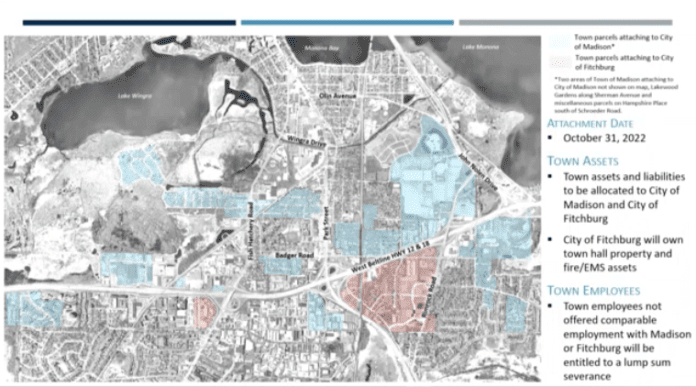
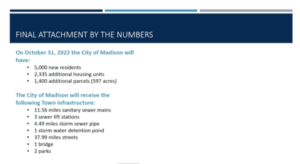




I was on the Fitchburg Plan Commission when the plan to divvy up the town of Madison was hatched — behind closed doors. The main concern was dividing up the physical assets. Human beings weren’t really in the assets column. They weren’t described that way, but everyone knew they were in the liability column. And they didn’t really enter into the political equation between Mayors Sue Bauman and Mark Vivian, and town chairman Jim Campbell. Location, location, location, and how to deal with a dysfunctional unit of government were the issues.